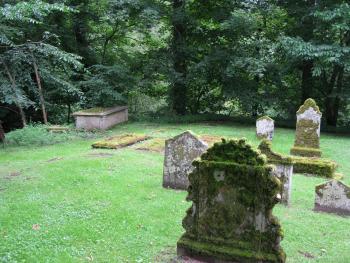- Navigation:
- Back to the Corpus index page
- RSS
Aberdalgie Parish Church
Aberdalgie Churchyard, looking towards presumed site of medieval church
- Dedication: unknown
- Diocese of Dunkeld
- Deanery of Fife and Strathearn
- County of Perthshire
- Perth and Kinross Council
- NO 0794 2025 ?
Summary description
The present church, which is a building of 1772 that was extensively remodelled in 1928, stands a short distance to the south-west of the site of its medieval predecessor. Nothing is known of the architectural form of the earlier building.
Historical outline
Dedication: unknown
Virtually nothing is known of the history of the church of Aberdalgie. It is not listed in Bagimond’s Roll, which suggests that it had been annexed fully to the episcopal mensa at an early date. It was still a mensal church of the bishop of Dunkeld at the Reformation, when the fruits of the parish were in the hands of the bishop and the Oliphant family.(1) Suggestions of a close connection with the mensal church of Tibbermore appear to have no greater foundation than the fact that the episcopal lands and revenues in the two adjoining parishes were often treated together in the financial records of the diocese. (2)
Notes
1. Kirk (ed.), Book of Assumptions, 303, 342, 346.
2. Cowan, Parishes, 2; Rentale Dunkeldense, 194-5, 209-10, 214, 215, 220, 223, 230, 234, 239.
Architectural description
The parishes of Aberdalgie and Dupplin were united in 1618. The present T-plan church was built for the Earl of Kinnoul in 1773. Much of what is now seen, however, dates from a remodelling and re-ordering on ecclesiological principles by Lorimer and Matthew in 1928-9.
The church of 1773 replaced the medieval building, which was on a lower terrace within the churchyard, about 60 metres to the north-east of the present building, where there is a grouping of earlier memorials. It was said that fragments of the old church were still in evidence in the earlier nineteenth century, though no records were made of it at that time and nothing of it is now visible. The site of the earlier church is commemorated by a monument of 1905 in the form of a table tomb, which marks the position of the burial vault of the Lords Oliphant. The chief feature associated with that burial place was an incised Tournai marble slab for Sir William Oliphant, who died in 1329/30. The slab, which is the finest example of its kind in Scotland, was removed to the modern church in 1904, where it is set within a recess on the south side of the chancel area. It has recently undergone careful conservation. Although the stone’s long exposure to the elements has left its surface badly laminated, the armoured figure of Sir William is still discernible, as are parts of the complex micro-architectural detailing of the tabernacle which frames it.
Bibliography
Cowan, I.B., 1967, The parishes of medieval Scotland, (Scottish Record Society), Edinburgh, 2.
Gifford, J., 2007, The Buildings of Scotland, Perth and Kinross, New Haven and London, 133-5.
Greenhill, F.A., 1948, ‘Notes on Scottish incised slabs (III), Proceedings of the Society of Antiquaries of Scotland, lxxxi, 99-110.
Hay, G., 1957, The architecture of Scottish post-Reformation churches, Oxford, 92, 268.
Kirk, J., 1995, The books of assumption of the thirds of benefices, (British Academy) Oxford, 303, 342, 346.
MacGibbon, D. and Ross, T., 1896-7, The ecclesiastical architecture of Scotland, Edinburgh, ii (1896), 551-3.
New Statistical Account of Scotland, 1845, Edinburgh and London, x, 879-81.
Rentale Dunkeldense, 1915, ed. R.K. Hannay, (Scottish History Society), Edinburgh, 194-5, 209-10, 214, 215, 220, 223, 230, 234, 239.
Royal Commission on the Ancient and Historical Monuments of Scotland, Canmore database.
Statistical Account of Scotland, 1791-9, ed. J. Sinclair, Edinburgh, xviii (1796), 155-7.
Map
Images
Click on any thumbnail to open the image gallery and slideshow.













